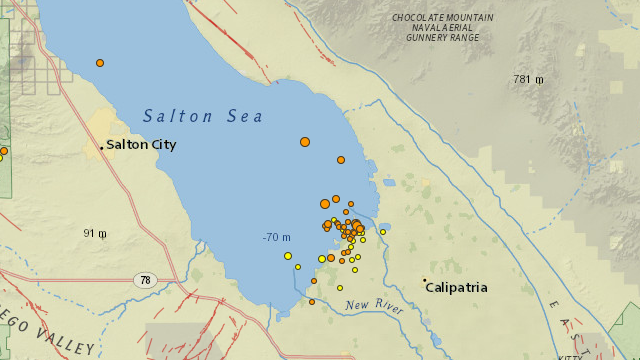Earlier this week, a cluster of dozens of little earthquakes occurred under the Salton Sea in southernmost California over the course of a couple of days. Most were too tiny to feel, and the largest—of magnitude 2.3—wasn’t big enough to be remarked upon. Specialists call this kind of thing an earthquake swarm, and while it seems like swarms ought to be telling us something, nobody yet has figured out what.

There are many kinds of movements going on in the deep earth, only some of which are earthquakes. (Others include tremor and creep and something in between called slow earthquakes.) Among earthquakes proper, the biggest ones are better understood than the rest—they’re big ruptures, called mainshocks— followed by a host of aftershocks that are best thought of as the mainshock rupture settling down to a relaxed state. Mainshocks may have a few foreshocks as well. Think of foreshocks like the crackling of a tree limb before it breaks.
Small earthquakes often occur in bursts. One kind of burst is the familiar “mainshock-aftershock sequence”, like a skyrocket with a large explosion followed by lots of littler ones. Earthquake swarms are the other kind. They’re more like a set of random-sounding drumbeats that start up, go on for a while without reaching a climax and then taper off to a stop. They happen all over the world in all kinds of tectonic settings. Swarms can include quakes up to magnitude 6 or so, big enough to do serious damage. But most earthquake swarms are either unfelt or mildly disquieting at worst. (Actually, so are most mainshocks.)
Earthquake swarms were first noticed almost a century ago, and researchers were quick to associate them with volcanic regions, where movements of magma underground would be an obvious cause. As our earthquake records have grown, we’ve found swarms in all kinds of geologic settings. In a pair of papers in 2006, John Vidale studied hundreds of swarms in southern California and Japan and found that they occurred everywhere, not just near volcanoes. He and his colleagues found that the majority of earthquake bursts were a blend between pure mainshock-aftershock sequences and typical swarms. It comes as no surprise that Earth doesn’t give us many clean test cases.
Researchers have proposed two main mechanisms for earthquake swarms. One is that underground fluids under high pressure are cracking the rocks in small events. Like people in a crowded bus making room for a group of boarding passengers, the rocks respond to the migration of the fluids and their associated pressures. A recent study in Italy slightly favored that explanation for a swarm of over 5000 earthquakes that has been going on since 2010. This also makes sense for swarms that occur beneath volcanoes. In the Bay Area, we have a constant artificial earthquake swarm around The Geysers, where a large geothermal power plant is constantly pumping water down onto superheated volcanic rocks and harvesting the steam to generate electricity.
